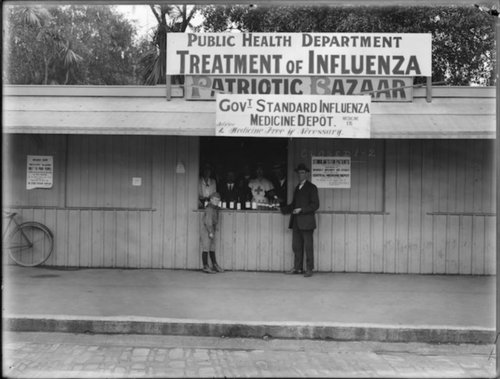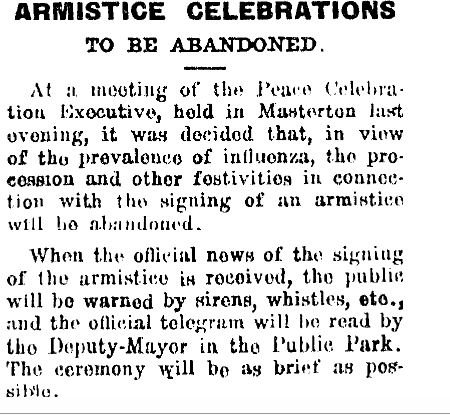
By Sarah Johnston
Hero image: New Zealand gunners at Le Quesnoy, 1918. (Courtesy Alexander Turnbull Library Ref: 1/2-013684G)
"This priority message came through. It starts off: ‘The following from Third Army: hostilities will cease at 1100 hours.’ Well, of course when it came to hostilities going to cease, well I don’t know, it sort of gave you an attack of the jitters. You didn’t know whether you were writing it down properly or not!"

Armistice telegram received in New Zealand by Governor-General Lord Liverpool. (Courtesy Archives New Zealand - R3796227)
An Armistice with Germany had been signed. George took down the telegraph message, sent in Morse code, at his New Zealand Division signal station in northern France. He wrote it out in pencil, and when he was interviewed for radio some 50 years later in the 1960s, proudly showed the interviewer the original pencil which he had kept – and the original message. On November 11, 1918 he had quickly run off copies of the telegraph message using carbon paper, for distribution and souvenirs – but kept the original himself.
George’s memories are recorded in our sound archives – one of several sound recordings about the Armistice in the RNZ Collection at Ngā Taonga Sound & Vision. You can listen to the full recordings in our online catalogue, via the links at the end of this blog post.

Article from the Southland Times, 11 Nov 1918.
At Beaudignies near the walled French town of Le Quesnoy, (liberated by New Zealand from German occupation just a few days earlier), Bob Robertson of the Hauraki Regiment recalls there wasn’t a lot of celebrating.
"A chap came riding through to say the war had ended… We always said that when the war ended we were going to do this, do that, get blind drunk, goodness knows what. When we heard this announcement, we were so all-in, so tired – we just looked at the man next to you and said ‘What do you think of that?’ That was about all we could say."

Māori Pioneers at Le Quesnoy, 1918. (Courtesy Russell Stowers Collection)
However, fellow Tauranga veteran, George Puhi Nicholas (Ngāi Te Rangi, Ngāti Ranginui, Ngāti Haua, Ngāti Ruanui) who was with the Māori Pioneers at Le Quesnoy, did remember celebrating with the local French people.
"We started jumping around. got a lot of the civilians in there, started dancing around with everybody. I’ve never done so much dancing in me life. We was that pleased the war was over and we had a jolly good time."

Cells at Waikeria Prison, (1923).
Back home, the news of the Armistice was heard in a cell at Waikeria Prison by a conscientious objector Edward Dowsett, who was serving a two-year sentence of hard labour, for refusing to fight due to his Quaker faith.
"We were told by the warders and given a holiday, which meant being shut up in our cells all day. My first thought was one of …immense relief. My immediate reaction.. was to break the law and sing. I sang Edward Carpenter’s poem “England arise, the long, long night is over.” Then I began to wonder whether it really was? And my next thought was, I hoped we had learnt our lesson and would not be such fools as to again embark on a wide-scale war - or any war at all."
Despite the war’s end, Edward was required to serve out the remaining nine months of his prison sentence.

Influenza medicine depot in Christchurch, 1918. (Courtesy Alexander Turnbull Library Ref: 1/1-008542-G)
Tragically, the Armistice celebrations coincided with the terrible 1918 influenza epidemic which was beginning to take hold in New Zealand cities such as Auckland. Nurse Isobel Haresnape had come to the city to nurse influenza patients.
"I woke next morning to a tremendous noise of sirens, bells ringing and voices and feet running and everyone wanting to know what it was all about, and I was one of them. And I heard someone say “It’s peace!” I went down to Queen Street where I saw this excitement, people had benzine tins – I remember one band was out…and there were a lot of makeshift bands, people with combs with paper over them, blowing them, banging anything that they could bang to make drums and I got a benzine tin too, from somewhere and banged it. People were very hysterically excited really, people who didn’t know each other, strangers kissed strangers, went drinking with them in hotels…danced with them, everyone was dancing…the general public wasn’t aware of the ‘flu – except those that had it."

Article from the Taranaki Daily News, 9 Nov 1918.

Article from the Wairarapa Times Age, 12 Nov 1918.
Full length original sound recordings can all be heard online on our web catalogue:
All recordings are from the RNZ Collection. (Ngā Taonga Sound & Vision)